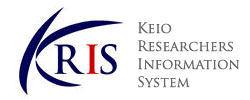-
Affiliation
-
School of Medicine, Department of Preventive Medicine and Public Health (Shinanomachi)
-
Position
-
Senior Assistant Professor (Non-tenured)/Assistant Professor (Non-tenured)

KEIO RESEARCHERS INFORMATION SYSTEM |
Details of a Researcher
このページはJavascriptを使用しています。すべての機能を使用するためにはJavascript を有効にする必要があります。
Miyagawa, Naoko
|
|
|
Toki R., Fushiki S., Kojima S., Sutoh Y., Otsuka-Yamasaki Y., Harada S., Iida M., Hirata A., Miyagawa N., Matsumoto M., Edagawa S., Miyake A., Kuwabara K., Hirayama A., Sugimoto M., Sato A., Amano K., Soga T., Tomita M., Arakawa K., Kinoshita K., Sakurai-Yageta M., Tamiya G., Ohmomo H., Shimizu A., Okamura T., Takebayashi T.
Scientific Reports 15 ( 1 ) 14569 2025.12
ISSN 2045-2322
Ohashi Mizuki, Miyagawa Naoko, Yanagita Masahiko, Okuda Nagako, Fujiyoshi Akira, Ohkubo Takayoshi, Kadota Aya, Okami Yukiko, Kondo Keiko, Harada Akiko, Okamura Tomonori, Ueshima Hirotsugu, Okayama Akira, Miura Katsuyuki, for the NIPPON DATA2010 Research Group
Journal of Atherosclerosis and Thrombosis (Japan Atherosclerosis Society) 32 ( 10 ) 1328 - 1346 2025.10
ISSN 1340-3478
Ishida N, Harada S, Toki R, Hirata A, Matsumoto M, Miyagawa N, Iida M, Edagawa S, Miyake A, Kuwabara K, Shibuki T, Kato S, Arakawa K, Kinoshita K, Sakurai-Yageta M, Tamiya G, Nagashima K, Muraoka H, Sato Y, Takebayashi T
Journal of diabetes investigation 16 ( 7 ) 1305 - 1314 2025.04
ISSN 2040-1116
Goto C., Imaeda N., Wakai K., Sasakabe T., Michihata N., Oze I., Hosono A., Nagayoshi M., Miyagawa N., Ozaki E., Ikezaki H., Nanri H., Ibusuki R., Katsuura-Kamano S., Kuriki K., Yaguchi Y., Kurihara A., Matsuo K.
Nagoya Journal of Medical Science 87 ( 2 ) 237 - 253 2025
ISSN 00277622
Htay Z.W., Michihata N., Nakamura Y., Hippo Y., Otonari J., Ikezaki H., Nishida Y., Shimanoe C., Tamura T., Nagayoshi M., Kato Y., Tamada Y., Hishida A., Tanoue S., Nishimoto D., Koyama T., Ozaki E., Kuriki K., Takashima N., Miyagawa N., Katsuura-Kamano S., Watanabe T., Wakai K., Matsuo K.
European Journal of Clinical Nutrition 2025
ISSN 09543007
Do mothers’ socioeconomic factors affect children’s sodium and potassium intake?
Miyagawa N.
Hypertension Research 48 ( 4 ) 1646 - 1648 2025
ISSN 09169636
日本人における乳製品摂取と総死亡、がんおよび循環器疾患死亡リスクの関連 J-MICC研究
宮川 尚子, 高嶋 直敬, 原田 亜紀子, 門田 文, 近藤 慶子, 中村 保幸, 三浦 克之, 上島 弘嗣, 今枝 奈保美, 後藤 千穂, 喜多 義邦, 若井 建志, 松尾 恵太郎
Journal of Epidemiology ((一社)日本疫学会) 34 ( Suppl. ) 100 - 100 2024.01
ISSN 0917-5040
宮川 尚子, 高嶋 直敬, 土岐 了大, 原田 成, 武林 亨, 岡村 智教, 門田 文, 三浦 克之, 上島 弘嗣, 喜多 義邦
日本循環器病予防学会誌 ((一社)日本循環器病予防学会) 58 ( 2 ) 153 - 153 2023.05
ISSN 1346-6267
Miyagawa Naoko
Journal of Atherosclerosis and Thrombosis (Japan Atherosclerosis Society) 30 ( 6 ) 587 - 588 2023
ISSN 13403478
一般住民における内臓脂肪の蓄積に関連するメタボロミクスプロファイル 鶴岡メタボロームコホート研究
宮川 尚子, 原田 成, 飯田 美穂, 桑原 和代, 加藤 寿寿華, 佐田 みずき, 松元 美奈子, 平田 あや, 岡村 智教, 武林 亨
Journal of Epidemiology ((一社)日本疫学会) 32 ( Suppl.1 ) 164 - 164 2022.01
ISSN 0917-5040
Japan Society for the Promotion of Science, Grants-in-Aid for Scientific Research, Grant-in-Aid for Scientific Research (B), No Setting
Japan Society for the Promotion of Science, Grants-in-Aid for Scientific Research, Grant-in-Aid for Scientific Research (B), No Setting
Japan Society for the Promotion of Science, Grants-in-Aid for Scientific Research, Grant-in-Aid for Scientific Research (A), No Setting
Association between the risk of sarcopenia and estimated protein intake using biomarkers
MEXT,JSPS, Grant-in-Aid for Scientific Research, Grant-in-Aid for Scientific Research (C), Principal investigator
日本学術振興会, Grants-in-Aid for Scientific Research, Grant-in-Aid for Early-Career Scientists, No Setting
NUTRITION FOR NURSING AND HEALTH CARE
2025
BIOSTATISTICS AND MEDICAL INFORMATICS
2025
NUTRITION FOR NURSING AND HEALTH CARE
2024
NUTRITION FOR NURSING AND HEALTH CARE
2023